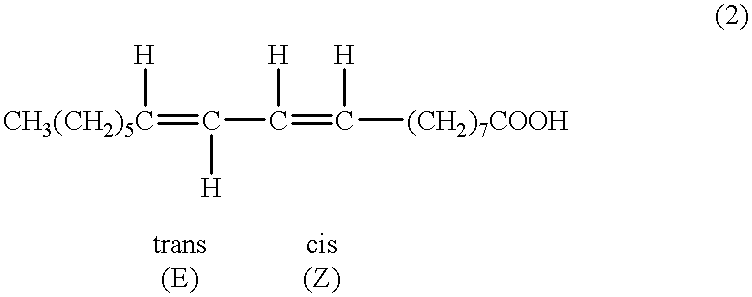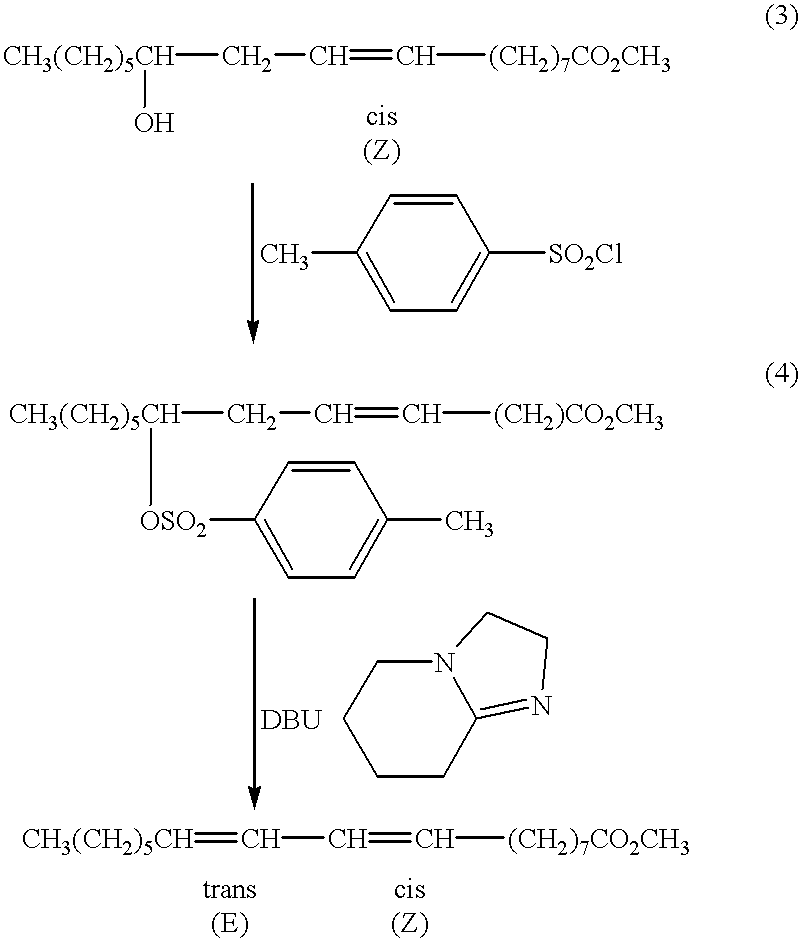Suppression of carcinoma using high purity conjugated linoleic acid (CLA)
a technology of conjugated linoleic acid and carcinoma, which is applied in the preparation of sulfonic acid esters, biocide, fatty acid chemical modification, etc., can solve the problem that the amount of fish oil needed to suppress tumors will exceed 10% in the di
- Summary
- Abstract
- Description
- Claims
- Application Information
AI Technical Summary
Problems solved by technology
Method used
Image
Examples
example ii
shows the reaction of methyl ricinoleate tosylate with DBU in acetonitrile. In the first step, only tosyl chloride was used. It is preferred for the elimination purpose. Iodide can also be used. However, oxygen is excluded since traces of elemental iodine can isomerize double bonds which is undesirable in the novel synthesis as used in the method of the present invention. Methane sulfonyl chloride also can be used. In the first step, pyridine is preferred as solvent and as base to neutralize the HCl produced in the reaction. Other solvents work much less completely and much more slowly.
In the second step, DBN or DBU is essential. Other bases have not worked. Particularly important is the use of bases that cannot cause substitution. Sodium hydroxide has been used previously on the chloride, not the tosylate, but a mix of isomers results in which the trans, trans [9(E),11(E)] isomer was the only one isolated in pure form.
The preferred solvent for the second step is acetonitrile, altho...
example iii
550 mg of a CLA sample which by GC was 74% methyl 9(Z),11(E)-octadecadienoate and 25% methyl 9(Z),11(Z)-octadecadienoate were dissolved in 70 ml ethanol in a 250 ml three-neck flask equipped with thermometer and gas inlet and outlet tubes. A slow stream of oxygen was passed over the liquid which was heated to 40.degree. C. with a heating mantle. One ml of 95% hydrazine was added and the temperature went to 45.degree. C. and stayed there. Samples of 20 ml each were taken at 30 minutes and 60 minutes and the reaction stopped at 90 minutes. The samples were acidified with concentrated HCl and the solvents evaporated, 10 ml water added and extracted with 10 ml hexane. Hexane solutions were used for GC determinations.
FIG. 3 shows the reaction mixture after 30 minutes. Both starting materials are reduced in content, some stearic ester has been formed, and among the products, cis-9 (also called oleate) predominates. There is more trans-11 (also called trans vaccenate) than cis-11 (also cal...
example iv
A. 1 g of ricinoleic acid methyl ester was refluxed in 30 ml acetic acid with 3 ml acetic anhydride added and 1 g of Amberlyst-15 as catalyst for 3 hours. Poured into 200 ml water and stirred for 30 minutes. Picked up in ether, ether layer washed with water and dried and evaporated. TLC shows new spot where oleate shows positive impurities and some starting material.
B. 1 g of methyl ricinoleate was treated with 3 ml acetic anhydride in 10 ml pyridine overnight. Poured into water and extracted with ether. TLC shows single spot higher than starting material (the acetate of ricinoleate). Product was refluxed for 5 hours in 50 ml toluene with 1 g Amberlyst-15 as catalyst.
Evaporation after washing with water and adding of ether gave a clear oil with the same spot as A (cleaner reaction). Product of A+B was passed through silica column with hexane and "oleate" spot obtained pure: 800 ma. Gas chromatography showed bizarre mixture.
Amberlyst-15 is a sulfonic acid resin. Acid catalyzed splitt...
PUM
| Property | Measurement | Unit |
|---|---|---|
| Fraction | aaaaa | aaaaa |
| Fraction | aaaaa | aaaaa |
| Fraction | aaaaa | aaaaa |
Abstract
Description
Claims
Application Information
 Login to View More
Login to View More - R&D
- Intellectual Property
- Life Sciences
- Materials
- Tech Scout
- Unparalleled Data Quality
- Higher Quality Content
- 60% Fewer Hallucinations
Browse by: Latest US Patents, China's latest patents, Technical Efficacy Thesaurus, Application Domain, Technology Topic, Popular Technical Reports.
© 2025 PatSnap. All rights reserved.Legal|Privacy policy|Modern Slavery Act Transparency Statement|Sitemap|About US| Contact US: help@patsnap.com



